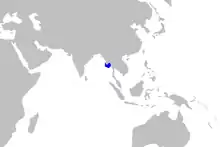Burmese bamboo shark
The Burmese bamboo shark, Chiloscyllium burmensis, is an extremely rare bamboo shark in the family Hemiscylliidae. The first specimen was caught 1963 off the coast from Rangoon in Burma in a depth of 29 – 33 m. This holotype is an adult male, 57 cm long and kept in the National Museum of Natural History, Smithsonian Institution, Washington DC.[2] Later, three more specimens, two males and one female, were recorded 2018 from the Bangladesh Fisheries Development Corporation Fish Landing Center of Cox’s Bazar. [3]
| Burmese bamboo shark | |
|---|---|
| Scientific classification | |
| Domain: | Eukaryota |
| Kingdom: | Animalia |
| Phylum: | Chordata |
| Class: | Chondrichthyes |
| Order: | Orectolobiformes |
| Family: | Hemiscylliidae |
| Genus: | Chiloscyllium |
| Species: | C. burmensis |
| Binomial name | |
| Chiloscyllium burmensis Dingerkus & DeFino, 1983 | |
 | |
| Range of the Burmese bamboo shark (in blue) | |
Description
The dorsal fin of the Burmese bamboo shark has straight rear margins. They are relatively small in size and have a slender body, blunt snout, and small eyes. [3] It has no particular color pattern.
Diet
They eat small bony fish or invertebrates.[4]
Reproduction
It is presumed to be oviparous (egg laying).
See also
References
- VanderWright, W.J.; Bineesh, K.K.; Haque, A.B.; Maung, A.; Derrick, D. (2020). "Chiloscyllium burmensis". IUCN Red List of Threatened Species. 2020: e.T161616A124515789. doi:10.2305/IUCN.UK.2020-3.RLTS.T161616A124515789.en. Retrieved 19 November 2021.
- Howe, J. C. & Springer, V. G. "Catalog of Type Specimens of Recent Fishes in the National Museum of Natural History, Smithsonian Institution, 5: Sharks (Chondrichthyes: Selachii)". Smithsonian Contributions to Zoology. Number 540, 1993
- Ahmed, M.S., Chowdhury, N.Z., Datta, S.K. et al. New Geographical Record of the Burmese Bamboo Shark, Chiloscyllium burmensis (Orectolobiformes: Hemiscylliidae), from Bangladesh Waters. Thalassas 35, 347–350 (2019).
- Compagno, Leonard. Sharks of the World. Shark Research Center Iziko-Museums of Cape Town. No. 1. Vol 2. Cape Town South Africa: Food and Agriculture Organization of the United Nations, 2002. Pg 169.
- Froese, Rainer; Pauly, Daniel (eds.) (2006). "Chiloscyllium burmensis" in FishBase. July 2006 version.
- Compagno, Dando, & Fowler, Sharks of the World, Princeton University Press, New Jersey 2005 ISBN 0-691-12072-2
